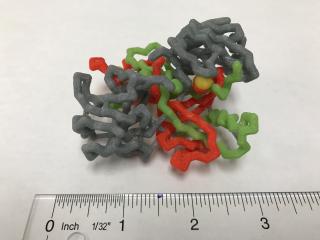Advanced Project: Protein Structure and Folding
The 2024-2025 WSSP offers the opportunity for up to two groups of students (1-2 students per group) from each school to participate in creating a physical model of a homolog of proteins identified during the screening of the cDNA library at their school during the academic year. This project is exclusively for advanced students who have completed the analysis of all their PCs and analyzed at least one unknown clone during the 2024-2025 project. This project will be a lot of work and can not be done in a short amount of time. Students will need to engage in reading original research articles on the structure and activity of their chosen protein and utilize molecular graphics programs to model it. Protein Modeling teams must adhere to assignment deadlines with no extensions or exceptions. Tentatively, models will be printed in May 2025, and students will present them at the WSSP poster session in June 2025. The WSSP will cover the printing costs for two models per school. We will also work with students/teachers if they want to try to print a model on a printer at their school.
The project commences in March 2025, with students required to attend two (and maybe 3) mandatory in-person meetings at the Waksman Institute from 4:00 to 7:00 PM on 4/1/25 and 4/15/25. These meetings will provide background information for the project and require students to present their findings. Both students in each group must attend both meetings.
4/1/25 Meeting: At the first meeting members from each group will do a short (3-5 min, 3-5 slides) oral presentation describing the background and function of the protein they are working on. An alignment of the homology between the Landoltia protein and the one in the PDB that you are going to model should be presented. NOTE: If you only have a partial protein sequence you should use the matches in the TSA search to determine the full-length protein sequence and show the alignment of that with the protein from the PDB. NO structural should be presented at this meeting. In the second half of the meeting, we will go over the Jmol protein modeling program and describe the 7 different models you will need to create before the next meeting.
4/15/25 Meeting: At the meeting on 4/15/25 each group will present the structural information about their protein. Groups will then finalize their models to be printed.
5/1/25: All work on models must be completed by this time. Students may be required to attend a 3rd meeting to describe the model that they will build.
Proteins chosen for modeling must not be components of large complexes like those found in ribosomal or photosynthesis complexes. Ideally, proteins should exist in monomer or dimer (homo- or heterodimer) structures.
Applications should include the following information from each group of 1 or 2 students:
Contact wssp@waksman.rutgers.edu if you have questions about the program or your protein/structure
Registration deadline for groups is 3/15/25. Go to https://forms.gle/NkYywftWtsvHRMTv7 to enter in the information shown below.
Please make sure that both members of the team can devote the time to the project. Participation is limited, with only two groups per school eligible. In the event of more than two group applications from the same school, selection will be first submitted bases. Additional groups may be invited if enrollment is not too large.
|
||||||||||||||||||||||||||||
Protein Modeling Resources
WSSP Protein Modeling Worksheet

